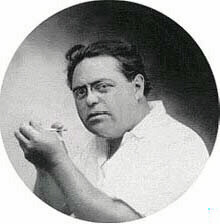Jacques Heath Futrelle para niños
Datos para niños Jacques Futrelle |
||
|---|---|---|
 |
||
| Información personal | ||
| Nombre en inglés | Jacques Heath Futrelle | |
| Nacimiento | 9 de abril de 1875 condado de Pike, estado de Georgia, Estados Unidos |
|
| Fallecimiento | 15 de abril de 1912 , océano Atlántico norte |
|
| Causa de muerte | Ahogamiento | |
| Nacionalidad | estadounidense | |
| Lengua materna | inglés | |
| Familia | ||
| Cónyuge | May Futrelle | |
| Información profesional | ||
| Ocupación | escritor de misterio, periodista | |
| Años activo | 1905-1912 | |
| Lengua literaria | inglés | |
| Género | ficción detectivesca | |
| Sitio web | ||
Jacques Heath Futrelle (nacido en el condado de Pike, Estados Unidos, el 9 de abril de 1875 – fallecido en el océano Atlántico el 15 de abril de 1912) fue un escritor de misterio y periodista estadounidense.
Es muy recordado por sus emocionantes cuentos de detectives. En ellos, el personaje principal era el profesor Augustus S. F. X. Van Dusen. A este personaje lo llamaban "La Máquina Pensante" porque usaba la lógica de forma increíble para resolver cualquier misterio. Jacques Futrelle falleció en el trágico hundimiento del famoso barco transatlántico RMS Titanic.
Contenido
La Vida y Carrera de Jacques Futrelle
Sus Primeros Años y el Periodismo
Jacques Futrelle nació en el estado de Georgia. De joven, se mudó a Atlanta, donde empezó a trabajar en el periódico Atlanta Journal. Allí se encargaba de la sección de deportes.
Más tarde, trabajó para otros periódicos importantes como el New York Herald, el Boston Post y el Boston American. Fue en el Boston American, en el año 1905, donde apareció por primera vez su famoso personaje "La Máquina Pensante". Esto ocurrió en una historia publicada por entregas llamada El Problema de la Celda 13.
En 1895, Jacques se casó con Lily May Peel, quien también era escritora. Tuvieron dos hijos, a quienes llamaron Virginia y Jacques John Jr.
De Periodista a Novelista
En 1906, Futrelle dejó su trabajo en el periódico Boston American. Quería dedicarse por completo a escribir novelas. Se construyó una casa en Scituate, Massachusetts, a la que llamó "Stepping Stones" (que significa "Peldaños" o "Escalones"). Allí pasó la mayor parte de su tiempo hasta el día de su fallecimiento en 1912.
El Trágico Viaje en el Titanic
En abril de 1912, Jacques Futrelle y su esposa regresaban a Estados Unidos desde Europa. Viajaban a bordo del gran transatlántico Titanic. Cuando el barco comenzó a hundirse, Jacques se aseguró de que su esposa subiera a un bote salvavidas. Él insistió en que ella se salvara primero.
Su esposa recordó que la última vez que lo vio, él estaba fumando un cigarrillo en la cubierta del barco, junto al millonario estadounidense John Jacob Astor IV. El cuerpo de Jacques Futrelle nunca fue encontrado.
Lamentablemente, la madre de Jacques, Linnie Futrelle, falleció el 29 de julio de 1912 en su casa de Georgia. Se cree que su muerte fue causada por el gran dolor que sentía por la pérdida de su hijo.
Obras Póstumas
En 1912, después de su fallecimiento, se publicó su último libro, La Liga de mi Dama. En el prólogo de este libro, su esposa escribió una dedicatoria muy emotiva: "A los héroes del Titanic, dedico este libro de mi esposo". Esta dedicatoria estaba acompañada de una foto de Jacques Futrelle.
Jacques Futrelle en la Cultura Popular
- Jacques Futrelle aparece como personaje principal en la novela de misterio The Titanic Murders (1999), escrita por Max Allan Collins. Esta historia trata sobre dos misterios que ocurren a bordo del Titanic.
- También se le menciona en la novela El problema final (2023) de Arturo Pérez-Reverte, donde se le recuerda como "aquel Jaques Frutelle que murió en el Titanic".
Obras Destacadas
Jacques Futrelle escribió varias novelas y colecciones de cuentos. Aquí te presentamos algunas de sus obras más conocidas:
Novelas
- 1906: The Chase of the Golden Plate
- 1908: The Simple Case of Susan
- 1909: The Diamond Master (Esta novela fue adaptada al cine en dos ocasiones)
- 1909: Elusive Isabel
- 1911: The High Hand
- 1912: My Lady's Garter
- 1914: Blind Man's Bluff
Colecciones de Cuentos del Profesor Van Dusen ("La Máquina Pensante")
- The Thinking Machine (1907), que incluye historias como El Problema de la Celda 13 y El Hilo Escarlata.
- The Thinking Machine on the Case (1908), con cuentos como El Barco a Motor y El Observador de Cristales.
- Best "Thinking Machine" Detective Stories (1973), una recopilación de sus mejores historias.
- Great Cases of the "Thinking Machine" (1976), otra colección de casos famosos.
- Jacques Futrelle's Thinking Machine (2003), una colección más reciente de sus cuentos.
Véase también
 En inglés: Jacques Futrelle Facts for Kids
En inglés: Jacques Futrelle Facts for Kids

